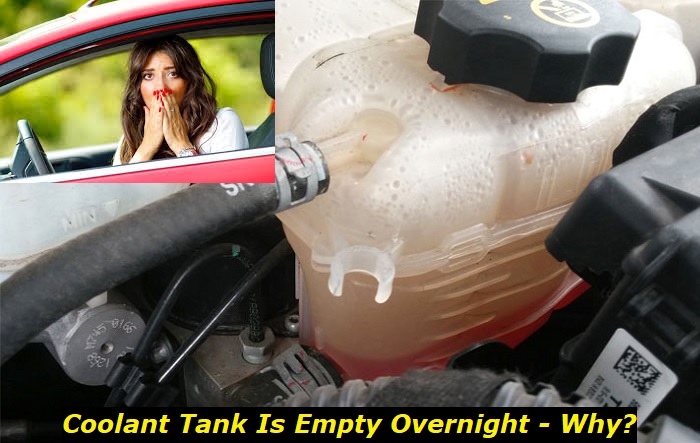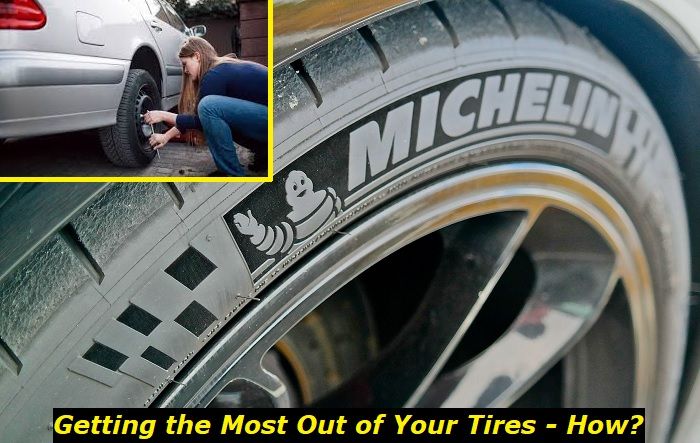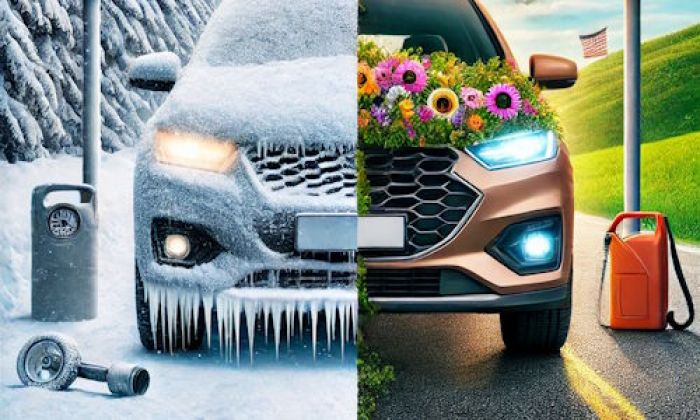What if you notice that your coolant tank is empty overnight? It may mean that there is a leak or you just didn't notice that the coolant was low even before you put your car in the garage. Locating and fixing the coolant leak is extremely important to let your engine live a long and happy life. Without being properly cooled, the engine will overheat and die immediately.
Coolant leaks highlights
- Level of urgency:very high
- Commonreasons:cooling equipment failure, pipe connections, radiator damage
- DIY diagnostics:possible but complicated
- DIY repair:mostly impossible
- Price of repair:$350 - $1,500
- Time for repair:3 - 8 hours
- If ignored:overheating, equipment failure

Checking the coolant - the importance of the procedure
To understand how important it is to check the coolant level from time to time, you need to know what happens with the engine if it's overheated.
First of all, the pistons may start scratching the cylinders and the piston rings may be worn out extremely fast. Also, the head is overheated and may change its shape which will destroy the head gasket. Additionally, the valves can get stuck and the rod bearings can move from their place making the engine fatally fail right there and then.
So, it's not OK to let your engine work when its temperature is too high. Eventually, you can just lose the engine.
Now, how should you check the coolant level in your car? Here are some concerns:
- You should check the level of the coolant at least once a week or whenever you suspect something may be wrong with the engine cooling system.
- Open the hood and look at the coolant reservoir. You will see the colored liquid in the white plastic tank. The tank has MIN and MAX marks - your coolant should be somewhere between them.
- Make sure the coolant is clean. Open the coolant tank cap and look at the surface. The coolant should be clean, you shouldn't see any oily film on it.
- You better check the coolant level and quality when the car is cold. You may be injured by hot vapors if you open the reservoir with the hot coolant in it.
You should immediately check the coolant level if your car is overheating, there are problems with the reading of the engine temp sensor, or you feel the odor of the coolant in your car. Very often, the culprit for these unpleasant things is actually the low level of coolant and you need to locate it before this problem kills the engine in your vehicle.
The coolant tank is empty in the morning - why?
It's very unexpected when you find your car with no coolant in it in the morning. There are two possible reasons for this. Of course, the most possible reason is the leak that took all the coolant out of the system and now the coolant reservoir is empty in the vehicle. But it also can be another problem and the coolant level may have been low for some time. When was the last time you checked it?
Let's have a look at both possible options:
1. Coolant leak
If you are totally sure that yesterday in the evening the coolant level was OK but today in the morning it's low, the problem is the coolant leak. Because of the leak, all coolant that is located above the leaking spot is now on the floor or in the engine compartment.
Here are the most common spots where coolant may leak:
- any coolant pipe - they may leak when damaged or just because of their age;
- connections with pipes - any connection can leak;
- thermostat - this is the device that switches between large and small circles of coolant circulation;
- water pump - if the pump is broken, it may leak and it's located quite low, so all the coolant will go out of the system;
- reservoir crack - your coolant tank can crack when too old;
- radiator - it's pretty common for radiators to leak because they may be damaged easily.
Also, you should check the common leak spots in your engine. Just google for the common problems with your engine and see if there are special units that can leak coolant in this engine model. Very often, you'll be able to find the actual problem in such a way.
2. Coolant burning
It's not uncommon for cars to develop a so-called inner coolant leak. You will not see any wet spots under the car because all the coolant will leak inside the engine and then it will be burned together with the fuel. This will give a lot of white smoke and contamination, so it's impossible to drive like that for a long time.
Coolant may get to the combustion chamber because of several possible reasons:
- head gasket problems - sometimes the gasket may leak the coolant directly to the cylinders;
- a cracked head or engine block - random cracks may also leak coolant to the cylinders or combustion chambers;
- EGR system - if you have a cooled EGR, it may be the reason why your coolant gets burned;
- a turbocharger - it's not uncommon for a turbocharger to leak coolant inside the engine.
So, many things can lead to the problem when the coolant in your car leaks inside the engine and then gets burnt. It means that the coolant level will quickly drop and the system will not be able to cool down the engine. After some time, the engine will start overheating and will eventually fail if not stopped on time.
Locating a leak in your cooling system
Before you call a tow truck and take your vehicle in for the inspection, you should see if there is anything you can do on your own. For example, if you locate the issue with the coolant tank, you may easily replace it on your own.
So, here's what you should check:
- try locating wet tracks of coolant leaks under the hood - inspect the engine compartment for any wet spots;
- also, look under the car and see if there is coolant - this will help you understand if the leak is external or internal;
- carefully inspect all the connections and clamps - maybe there is something cracked or loose and you can fix this easily;
- add a little coolant and see if it leaks now.
After locating the problematic spot, you can buy the needed parts and fix the issue. But you need to be sure that the inspection is correct and that you actually know the reason why your vehicle is leaking coolant. Otherwise, you will just spend a lot of money on parts and will not deal with the problem.
Dealing with the coolant leak - DIY or shop?
If you don't have any experience as a technician, you should be careful with any DIY tasks under the hood of your car. If something is done incorrectly, you may get a fatal engine problem after several miles. But still, you can try and locate the problem on your own so that the dealer won't steal your money by making up problems and diagnoses.
You can also solve the problem on your own unless it has some complications. For example, here are the issues you can solve without professional help:
- a clamp on a coolant hose is loose - you may tighten it easily;
- one of the hoses got off and you just need to put it back and tighten the clamp;
- there is a crack in the coolant reservoir - you can replace it, the tank is empty now, so it's not hard at all;
- the coolant is leaking through the cap - replacing the faulty cap is one of the easiest tasks.
These are DIY tasks even for those who don't have a lot of experience. If you want to do this in a shop, you will have to tow your vehicle there because driving it like that is not recommended.
Can you drive the car with no coolant in the tank?
Actually, no, you shouldn't drive a car with the leaking coolant because it will lead to overheating and serious problems with the engine. Even starting the engine with no coolant in the system is not recommended.
If you can add coolant and you see that the level holds there for several minutes, you can carefully drive. Control the engine temperature gauge - if the temperature goes over the half of the gauge, just stop the car and let it cool down. Then control the level of the coolant.
Also, make sure your car doesn't produce a cloud of white smoke from the tailpipe. This will mean that there is a huge internal leak and the engine shouldn't be driven to avoid serious damage.
Final thoughts
You should be careful with the coolant level in your car. The car should always have the proper coolant level - between the MIN and MAX marks in the reservoir. Otherwise, you will not be able to drive the vehicle for a long time. Sooner or later, the engine will just fail after fatally overheating.
Pay attention to any leaks and make sure you check the coolant level at least once every week or two. Also, use proper coolant of high quality and never try to buy the cheapest fluids for your car. This economy is totally not worth it.
About the authors
The CarAraC research team is composed of seasoned auto mechanics and automotive industry professionals, including individuals with advanced degrees and certifications in their field. Our team members boast prestigious credentials, reflecting their extensive knowledge and skills. These qualifications include: IMI: Institute of the Motor Industry, ASE-Certified Master Automobile Technicians; Coventry University, Graduate of MA in Automotive Journalism; Politecnico di Torino, Italy, MS Automotive Engineering; Ss. Cyril and Methodius University in Skopje, Mechanical University in Skopje; TOC Automotive College; DHA Suffa University, Department of Mechanical Engineering






Add comment